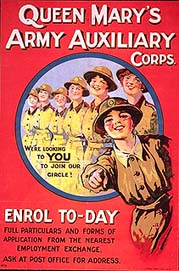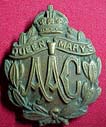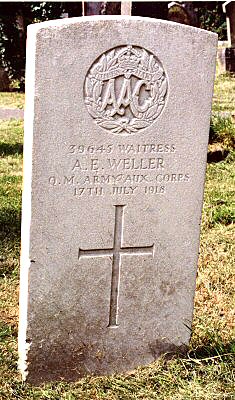Lady Maud Duckham, Waseda House, Highfields,
Ashtead, Surrey said the applicant was personally known for 2 years as her
Cook-Housekeeper. She would be quite suitable as a Waitress.
S Mould, Ironmonger, 1 Linden Road,
Leatherhead, Surrey said he had known the applicant for 20 years more or
less. She had spent some years in good class Domestic Service. He had met
her in Church & Sunday School work. She was Treasurer to funds in her
own church.
Ada was enrolled in the QMAAC on 30 May 1918. She drew the following
items of clothing, signing for each one:
Hat Badge
Frock Coat
Collars 3
Gaiters
Greatcoat
Felt Hat
Overalls 4
Shoes
Stockings 2pr
Shoulder Titles 2 sets
Washing Caps 2
On 31 May 1918 she transferred out of the QMAAC Connaught Club in
Seymour Street, London W, and on 2 June 1918 joined No 13 Quarter, 28
Warwick Square SW1. There was also reference to the Anzac Provost Corps,
Victoria, on 3 June 1918. One of their Sergeant-Majors attended her
funeral.
A month later she fell ill. The QMAAC Sick Hostel, 58 Holland Park,
W11, recorded that Ada was admitted to Hospital on 3 July 1918 and
discharged on 5 July with Pneumonia after those 3 days in hospital.
On 5 July she was transferred to the South London Hospital For Women,
103, South Side, Clapham Common, SW4. This was founded and incorporated
in 1912 and had an Out-Patient Department at 86-90 Newington Causeway.
AM Griffiths, House Physician at the South London Hospital, reported
that 39645 Weller AE QMAAC was suffering from Rt Basal pneumonia (3rd
day of disease). Consolidation spread to R. apex in the course of a few
days. The left lung became involved on Monday 15th & patient died at
3.20 am on Wednesday 17th having been unconscious all week. Griffiths
formally recorded the cause of death as Double Lobar Pneumonia.
Surrey Advertiser
Saturday 27 July 1918
THE LATE MISS A. E. WELLER
The funeral took place on Monday of Miss Ada Elizabeth Weller, daughter
of Mr. and Mrs. W. J. Weller, Poplar-road, Leatherhead, whose death
occurred the previous Wednesday after an an illness of only a
fortnight's duration. Deceased, who was 32 years of age, was a member of
an old and respected Leatherhead family, her father being an ex-member
of the Urban Council, a prominent member of the local Foresters and
local Liberal Association.
The late Miss Weller was a popular member of
the Leatherhead Wesleyan Church, being in the choir, a teacher in the
Sunday School, and having a Bible Class of her own. At the time of her
death she was working as a member of the W A.A.C.'s. [The WAAC was renamed
the Queen Mary's Army Auxiliary Corps on 9 April 1918 but
the new name was not generally adopted.]
A service was conducted in the Wesleyan Church
by the Rev. G. Panman (Horsham), previous to the interment in the parish
churchyard. The chief mourners were Mr. and Mrs. W. J. Weller (father and
mother), Will and Alf (brothers), Mabel, Florrie, Emily and Alice
(sisters). Mrs. Ben Weller and Mrs. George Weller (sisters-in-law) and
Miss Rowe and Sapper Bond. There were also present a sergeant-major of the
Australian Police Force, and number of W.A.A.C.’s from Warwick-square,
where deceased was stationed. There were numerous wreaths.
Her life
Ada Weller was born on 23 February 1886 in Leatherhead, Surrey.
In the 1891 Census, then aged 5, she was living in
Gravel Hill, Leatherhead. Her father was William J[ames] Weller, a
House Painter, born in Dorking. Her mother was Elizabeth Weller, née
Hammond, born in Wallington. They were married in Leatherhead on 10th
December 1875. Her siblings were William C (13), Albert J (11),
Charles H (6), George (3) and Frank H (1 month). All the children were
born in Leatherhead.
In the 1901 Census the 15 year old Ada was still in
Gravel Hill. No occupation was shown for her. The family now included
Flora E (8), Emeline M (7), Alfred E (5), and Alice M (3 months).
In the 1911 Census her parents were living in Fairfield
Road, Leatherhead, with Charles Henry Weller (26) and Alice Marion
Weller (10). However the Electoral Registers show
that her father remained in Gravel Hill until 1913. In 1914 he was in
Poplar Road, Leatherhead.
WOMEN IN THE FIRST WORLD WAR
The earliest of the women's voluntary
bodies was the First Aid Nursing Yeomanry (FANY) formed in 1909 with
memories of the South African war still fresh. It was recruited from
ladies who could ride well, with the aim of locating and retrieving
the wounded on horseback. Sensibly the FANY converted to a corps of
drivers and mechanics for ambulances. Though ignored by the British
Army, the FANY were appreciated by the French and Belgians. They
maintained a tradition of devotion and efficiency through both world
wars, retaining their separate identity even after joining with the
Auxiliary Territorial Service in WWII and from whose ranks were drawn
a number of those working underground in Nazi occupied Europe.
The first year of the First World War
produced a number of other women's voluntary organisations - the
Women's Emergency Corps, the Women's Auxiliary Force, the Women's
Volunteer Motor Drivers, the Home Service Corps and the Women's
Volunteer Reserve. The WVR was the most military in terms of uniform
and drill.
A major requirement was to cater for the
new armies - food was plentiful but was often wasted in preparation or
poorly cooked and thrown away by the men. The Quartermaster-General
Sir John Cowans realised that women could usefully employed in their
most traditional role, at least in non-combatant units or
establishments. He asked Lady Londonderry of the WVR if she could use
one of her organisations for this task.
As she was in disagreement with the
organisers of the WVR she opted to form a new corps, the Women's
Legion, a civilian organisation managed by volunteers with workers
recruited through the Labour Exchanges and paid through the Army Vote.
Her aim was to establish three sections - canteen, ambulance and
military cookery - but the immediate need was for cooks.
It was a great success and by the end of
1916 detachments totalling 2000 cooks and kitchen staff were working
at 200 camps in England. They were recruited from domestic cooks,
housewives with practical cooking experience and ladies with diplomas
in domestic science and untrained volunteers who were at first trained
in the kitchens. Improvements were seen in palatability and good
cooking - and the women proved to be more efficient than the men.
There was some resentment - few men wanted to exchange a safe billet
for the trenches. The Women's Legion was run by amateurs with great
efficiency. It continued to the end of the war but was overtaken by
the realities of modern warfare.
Manpower was draining from industry into
the trenches and women were taking their places in the factories. It
was realised that women might also replace men in some of the tasks
which supported the fighting men. Sir Nevil Macready, the
Adjutant-General, asked Haig in December 1916 if he would be prepared
to accept women in the 'static chain'. Haig agreed, requiring only
that they be properly organised and operate in groups of not less than
20 each under their own officers. A report recommended that just in in
France 12,000 women could be used as ambulance drivers, storemen,
clerks, checkers, telegraphists, telephonists, postal employees,
orderlies, cooks, and domestic servants.
Macready's assistant was Brigadier AC
Geddes whose sister, Mrs Mary Watson. had been the first woman to
graduate in Medicine from the University of Edinburgh and who had some
experience in public affairs. In February 1917 she was invited to
raise and command what was to be called the Women's Army Auxiliary
Corps. Helen Gwynne-Vaughan was the Controller (Overseas).
Eventually 57,000 WAAC were employed. The response was
swift and the planned establishment soon achieved. The first WAACs moved
to France on 31st March 1917. By early 1918, some 6,000 WAACs were in
France.
Inevitably there was eventually a furore back in England
and seized upon by German propaganda about women and soldiers serving
together. An enquiry was set up which effectively ended the fuss. More
critically, the German offensive in Spring 1918 caused concern in some
quarters about the exposure of women to enemy fire and the possibility
of withdrawal of the WAACs from France altogether. When it was proposed
that all the WAACs at the Signal Centre at St Omer should be sent back,
this order was cancelled, much to the satisfaction of the WAAC, by the
Director of Signals who said that if his 142 women who had behaved with
exemplary calm under air raids were removed, he could not be responsible
for communications between GHQ and Second Army. So ended the only
attempt to withdraw members of the Corps from duty for the sake of their
own safety.
Though non-combatant, members of the WAAC
had to put up with shelling by heavy artillery and German bombing
raids. During a bombing attack in April 1918, nine WAAC were killed at
the Etaples Army Camp. British newspapers claimed that it was another
German atrocity but Helen Gwynne-Vaughan, the redoubtable Controller
(Overseas) remarked to the press that the WAAC were in France as
replacements for soldiers and the enemy was entitled to view them as a
target.
|
In the midst of all this on 9 April 1918 came a
statement issued by Buckingham Palace:
"As a mark of Her Majesty's
appreciation of the good services rendered by the WAAC both
at home and abroad since its inauguration, and especially of
the distinction which it earned in France during the recent
fighting on the Western Front, Her Majesty has been
graciously pleased to assume the position and title of
Commandant-in-Chief of the Corps, which in future will bear
the name of Queen Mary's Army Auxiliary Corps."
This title was not generally adopted and the
WAACs stayed WAACs.
|
 |
The organisation of the WAAC partly reflected the military
model: their officers were called Controllers and Administrators, rather
than Commissioned Officers, and messed apart from the other ranks. The
WAAC uniform included a small, tight-fitting khaki cap, khaki jackets
and skirts. The skirt had to be no more than twelve inches above the
ground. To maintain a high level of fitness, all WAAC had to do
physical exercises daily, including morris dancing and hockey.
The WAAC version of an NCO was a Forewoman, and
the private was a Worker, as was Ada Weller.
A detachment of 1000 WAACs was requested by the American
Expeditionary Force and were an independent body under their own Chief
Controller. WAAC/QMAAC formally operated under the control of the War
Office and was a part of the British Army. Women enrolled
rather than enlisted. Breaches of discipline were punished by civil
rather than military courts.
A cadre of 6,000 WAAC transferred to the Royal Air Force
on the formation of the Women's Royal Air Force. The QMAAC formally
disbanded on 27 September 1921.
On 9th September 1938 the Auxiliary
Territorial Service was formed. ²
Rose Stovell who was
mentioned by Ada in her QMAAC application interview was baptised
on 16 November 1889 under the name Katherine Rose Stovell. The 1901
Census showed her living at Fetcham Common with her parents George, a
farm labourer and stockman and mother Grace Annie (née Diment).
She had a younger brother George Stovell born in 1902. The 1911
Census showed the family living in The Street, Fetcham. The Fetcham
Village School Log Book showed that she was unsuccessful in passing the
Labour Examination in July 1912 but successfully passed the following
July. Her brother left school in 1916 aged 14.
War Office Women’s (later Queen Mary’s) Army Auxiliary Corps Service
Records, First World War, 1917-1920, show that Rose served in the QMAAC.
[source: Surrey
in the Great War]
After WW1
According to the Electoral Registers Ada's
parents were at 3 Poplar Road until 1922 and for 1923-26 their address
was 35 Poplar Road, probably as the result of renumbering in the
road..
Both died in 1926. They and Ada are among
14 Wellers buried in the churchyard¹
of the Parish Church of St Mary & St Nicholas, Leatherhead:
F 815 WELLER Elizabeth b1855 d1926 age 71 died
11/07/1926
F 815 WELLER William James b1854 d1926 age 72 died 29/09/1926
Ruth Stovell married George Robbins Winter on 11 February
1922 at St. Mary’s Church, Fetcham. [source: Surrey
in the Great War]
As for Lady Duckham, after the end of the First World War,
builders were quick to acquire land in Ashtead where they could erect
houses for the purchase by outsiders, mainly Londoners.
The Warren
Estate was one of the areas developed at this time, mainly for
large houses. Even a golf course, begun as part of the planned Estate
development, but was never completed. With its spacious houses on large
plots, the Estate attracted men who had done very well out of the war
and able to pay the then very high prices of around £2,000 to £3,000.
One of the most impressive of these houses was High
Warren, finished in 1922 and containing three oak panelled
reception rooms and six bedrooms. This was for many years the residence
of Sir Arthur and Lady Maud Duckham. Sir Arthur McDougall Duckham born
in 1879 at Blackheath, London, was a Gas Engineer. He was one of the
founders of the Institution of Chemical Engineers, and its first
President. He was Knighted for services rendered in the Ministry of
Munitions during the Great War. In 1928 he led a British trade mission
to Australia, and following this received a further knighthood, GBE.
He died in 1932 and is buried in St Giles' Ashtead
graveyard.
Lady
Maud was President of Ashtead Horticultural Society in 1937 and,
after retiring as President, remained as Vice-President until 1958. She
died in Richmond, Surrey on 12 June 1967.
Ada Weller is remembered on these memorials
Leatherhead Methodist Church
Surrey
in the Great War
Other Sources
1. SSMN Leatherhead graves inscriptions database; Ancestry.co.uk for
most of the other genealogical data.
2. The Women's Royal Army Corps, Shelford Bidwell
3. Women in Khaki, Roy Terry
The late Mrs Joan Ralph of Poplar Road, Leatherhead, an
ATS Gunner in WWII, loaned sources 2&3.
Links
The
Long, Long Trail - Women's Organisations
Western
Front Association: We too were Soldiers
IWM:
The Vital Role of Women in the First World War
the website editor would like to add
further information on this casualty
e.g. a photo of her, and of any recollections within her family
with thanks to Brian Bouchard for identifying Ada
Weller's file reference
last updated 10 Aug 04: 18 Feb 14: 5 Mar 18: 5 Sep 20


